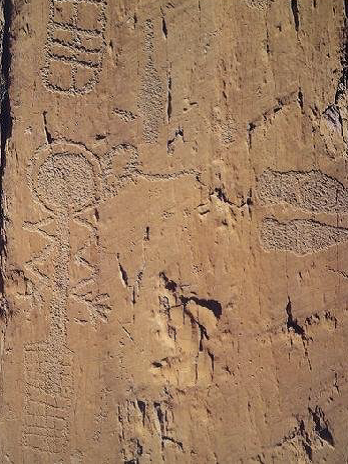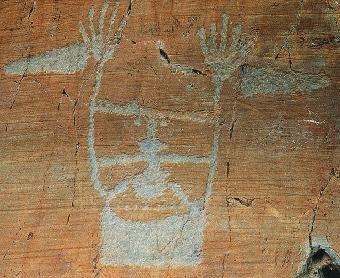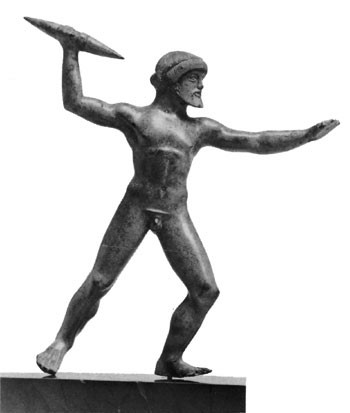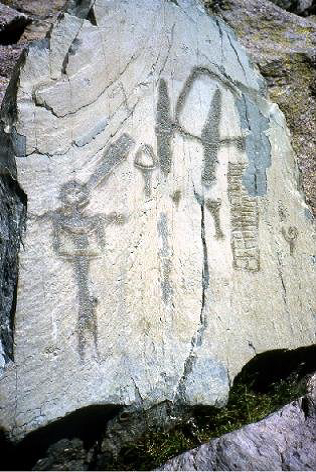Mount Bégo: an electrical mountain
Mount Bégo, which is geologically rich in metals and remarkable by its abundance of springs and lakes, is an electrically highly charged locus, known even today for its violent thunderstorms, occurring all through the year, which gave its name to the Valley of Marvels. (See The Petroglyphs of Mount Bégo.) Jean-Paul Orcier, in a 2012 conference, gives the etymology of its very ancient name as “Be,” the sacred mountain of thunder and lightning, abode of the bull-shaped god “Go.” (Although he doesn’t state precisely to what language he associates these vocables.)
Ralph Juergens was the first to make out a thunderbolt, a plasmoid, in the ovoid missile hurled by Zeus. Could this extraordinary anthropomophic petroglyph of Mount Bégo be representing a thunderbolting god, hurling plasmoids with both hands?
And what does the shape coming out of, or hitting, the left side of the head of the largest and most prominent petroglyph signify? Another plasmoid? Is he spouting a deluge of rain? Could it be a cometary head of hair? The figure is thought to represent the great God, the checkered form next to him representing the Great Mother, in the appearance of a parcelled-out piece of agricultural land.

Is this a cometary shape? A Z-Pinch plasma figure? Does it represent a croquis of an annular solar eclipse at 5:30 (local time) in the morning of October 10th, 1718 B.C. as some archeoastronomers have proposed?
Taranis, by Bernard Sergent
The authors of the petroglyphs of Mount Bégo were certainly not Celts, as these reached the Parisian Basin only around 1700 B.C. and the South of France several centuries later. Still, it is generally admitted that they were already Indo-Europeans,[1] and I myself am thinking they are Ligurians, out of archaeological considerations, from the fact that, judging by the shape of their weapons, the authors of the petroglyphs are said to belong to a Bronze Age civilization called “rhodanian” in France and “Polada” in Italy, a culture which has its roots in the UnjetiCe culture of the III millennium,[2] from which the Celtic cultures (called successively of the Tumuli, of Hallstatt and of La Tène) also proceed: as it happens, the Ligurians are linguistically related to the Celts,[3] and they seemed to have been so religiously as well, as the personage which gave its name to the island of Lero, and to the present Iles de Lérins, carries exactly the name of a Celtic god of the sea.[4]
So that a study of the god associated with lightning among the Celts can be considered pertinent for the study of the religion of the people to which we owe the petroglyphs around Mount Bégo. We know indeed that the “Marvels,” which give their name to the Lake of Marvels, are nothing else than the prodigious thunderstorms which hit this mountainous area; as for the petroglyphs, we know that the numerous figurations of daggers and hallebards were associated to celestial phenomena, where these weapons are meant to represent to fire of heaven.[5] We are precisely going to see that the Celtic god of thunder is armed with a missile-type weapon which is close to the aforesaid. And the “anthropomorph brandishing a dagger”[6] is much reminiscent of the Celtic thundergod.
This latter god is indeed well known to us through the abundance of documents from the gallo-roman period: under the Roman name of Jupiter, he is found in a considerable number of inscriptions and figurations, and some of the inscriptions attribute to him the divine epithet of Taranis, which is often considered to be his authentic Celtic name.[7]
Precisely, this name of Taranis is easy to explain. In the known Celtic languages (that is, those posterior to antiquity, as the ancient Celtic languages are barely known), the word taran signifies “thunder:” in breton, in welsh, and in ancient Cornish (language once spoken in British Cornwall); it is found again in Irish in the form torann.[8]
And the antic figurations are in accordance with the name: the “Gallo-Roman Jupiter,” that is, Taranis, is often represented holding an elongated object, often oblong at both extremities, which can easily be interpreted as an image of lightning, and which he is ready to hurl. (See the emblem of the “Electric Universe!” - note of the translator…)
Bernard Sergent
(Translated by Anne-Marie de Grazia)
from: Jérôme Magail, Jean-Marc Giaume, eds. Le Site du Mont Bégo de la protohistoire à nos jours, Actes du Colloque de Nice 15-16 mars 2001, Nice, Serre. Article by Bernard Sergent, researcher at the Centre National de la Recherche Scientifique (CNRS). (partial.)
[1] Masson, 1993 ; Dufrenne, 1997.
[2] Sergent, 1995 c. 416. Cf Kruta, 1994 : at the end of the III millennium, the spread of the UnjetiCe culture reaches Southern France and Northern Italy. From then until the period of La Tène, there is “an absence of any significant rupture.” Dufrenne, 1997, 197-198, is of the opinion that the first “carvers” of this area belonged to the civilization of the campaniform vases. It is possible that these were at the origin of these works, and that the carriers of the Rhodanian civilization then picked up from there. At any rate, the linguistic question is most complex.
[3] Id., 50-51.
[4] Fromage, 2000, 228-229 ; Sergent, 2000 c. 239 – these articles go back in fact to 1992.
[5] P.e. Masson, 1993, 110-113.
[6] P.e. Dufrenne, 1997, 132.
[7] List of forms, epigraphic and toponymic, in Le Roux, 1958, 30-31, and in Hainzmann, 2002, et passim.
[8] Duval, 1993, 29 ; Lambert, 1994, 60 ; Delamarre, 1982, 245.





